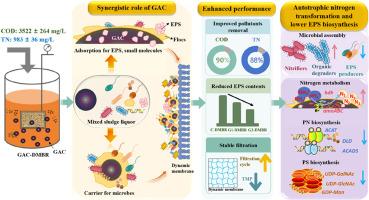Enhancing operational stability and pollutants removal in dynamic membrane bioreactors via granular activated carbon for landfill leachate treatment
IF 9
1区 工程技术
Q1 ENGINEERING, CHEMICAL
引用次数: 0
Abstract
Polymeric membrane-based technology has been widely engineered to facilitate efficient treatment of landfill leachate. However, low membrane filtration flux and severe membrane fouling greatly hampered its low-cost application. In this study, a dynamic membrane bioreactor (DMBR) integrated with granular activated carbon (GAC) was proposed to enhance both filtration performance and pollutants removal from high-strength landfill leachate. Under influent COD and NH4+-N were 3522 ± 264 and 983 ± 36 mg/L, GAC-DMBR achieved effluent COD and total nitrogen of 367 ± 45 and 114 ± 20 mg/L, respectively. A dynamic membrane (DM) layer was rapidly formed within 0.5 h and sustained stable operation for a cycle of about 33 days at a constant flux of 10 LMH. GAC addition facilitated the formation of a thicker but more permeable DM layer through enhanced sludge aggregation and significant reduction in extracellular polymeric substances (EPS). Microbial analysis revealed GAC-induced enrichment of nitrifiers (e.g., Nitrosomonas, Nitrobacter) and organic degraders (e.g., Candidatus Promineifilum), alongside reduced abundance of EPS-producing genera (e.g., Anaerolinea) and denitrifiers (e.g., Thauera, Ottowia). These community shifts aligned with the higher abundances of genes involved in nitrification, anammox, along with the lower abundances of denitrification and EPS biosynthesis. All these changes promoted a transition toward autotrophic nitrogen removal (ANR) and effectively mitigated membrane fouling. This study offers a promising approach for improving the efficiency and operational sustainability of landfill leachate treatment systems using GAC-mediated DMBR technology.

颗粒活性炭处理垃圾渗滤液提高动态膜生物反应器的运行稳定性和污染物去除率
高分子膜技术已广泛应用于垃圾渗滤液的有效处理。但膜过滤通量低,膜污染严重,严重阻碍了其低成本应用。本研究提出了一种动态膜生物反应器(DMBR)与颗粒活性炭(GAC)相结合,以提高高强度垃圾渗滤液的过滤性能和去除污染物的能力。在进水COD和NH4+-N分别为3522±264和983±36 mg/L的条件下,GAC-DMBR出水COD和总氮分别为367±45和114±20 mg/L。在0.5 h内快速形成动态膜(DM)层,并在10 LMH恒定通量下持续稳定运行约33天的周期。添加GAC通过增强污泥聚集和显著减少细胞外聚合物质(EPS),促进了更厚但更具渗透性的DM层的形成。微生物分析显示,gac诱导的硝化菌(如亚硝化单胞菌、硝化杆菌)和有机降解菌(如候选菌)富集,同时产生eps的属(如厌氧菌)和反硝化菌(如Thauera、Ottowia)的丰度降低。这些群落变化与参与硝化、厌氧氨氧化的基因丰度较高以及反硝化和EPS生物合成的基因丰度较低一致。这些变化促进了向自养脱氮(ANR)过渡,有效地缓解了膜污染。本研究为利用gac介导的DMBR技术提高垃圾渗滤液处理系统的效率和运行可持续性提供了一种有希望的方法。
本文章由计算机程序翻译,如有差异,请以英文原文为准。
求助全文
约1分钟内获得全文
求助全文
来源期刊

Journal of Membrane Science
工程技术-高分子科学
CiteScore
17.10
自引率
17.90%
发文量
1031
审稿时长
2.5 months
期刊介绍:
The Journal of Membrane Science is a publication that focuses on membrane systems and is aimed at academic and industrial chemists, chemical engineers, materials scientists, and membranologists. It publishes original research and reviews on various aspects of membrane transport, membrane formation/structure, fouling, module/process design, and processes/applications. The journal primarily focuses on the structure, function, and performance of non-biological membranes but also includes papers that relate to biological membranes. The Journal of Membrane Science publishes Full Text Papers, State-of-the-Art Reviews, Letters to the Editor, and Perspectives.
 求助内容:
求助内容: 应助结果提醒方式:
应助结果提醒方式:


